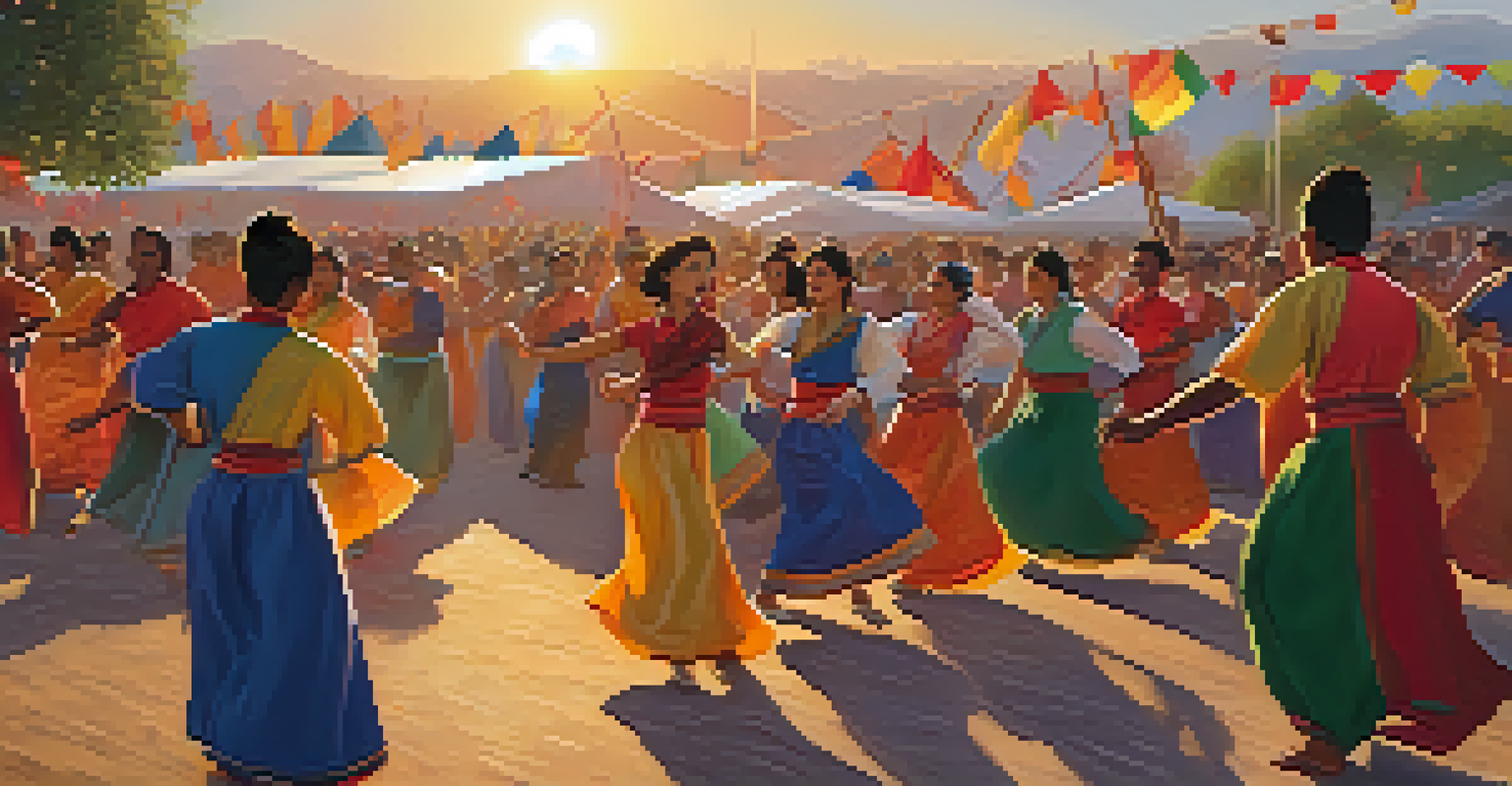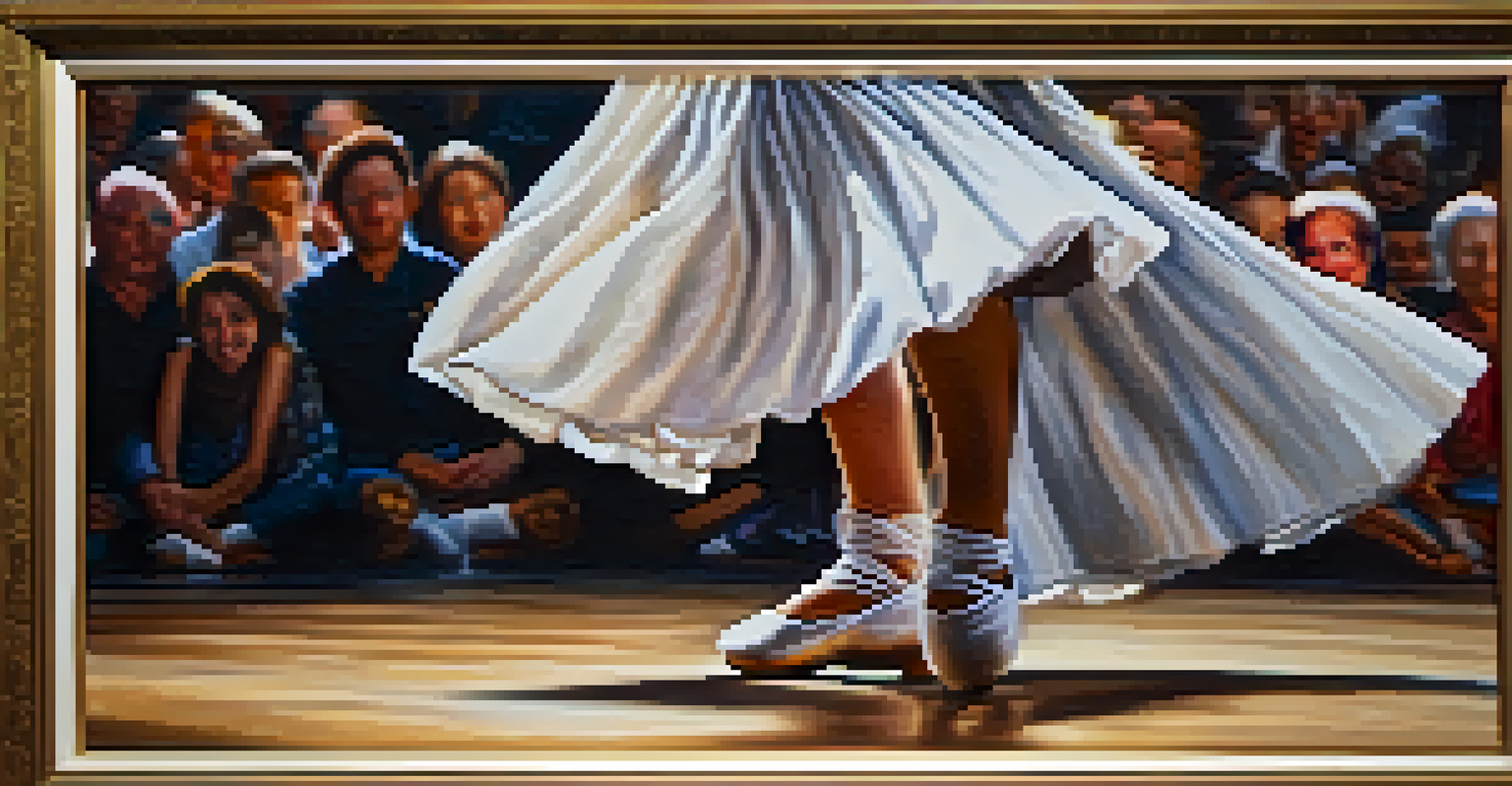Influence of Social Media on Cultural Appropriation in Dance

Understanding Cultural Appropriation in Dance
Cultural appropriation in dance refers to the adoption of elements from one culture by members of another, often without permission or understanding. This phenomenon can lead to the dilution of cultural significance and misrepresentation. For example, when a dance style rooted in a specific cultural tradition is performed without acknowledgment, it can perpetuate stereotypes.
Cultural appropriation is often a byproduct of a lack of understanding and respect for the original culture.
In dance, cultural appropriation can manifest in various ways, such as the commercialization of traditional movements or the performance of dances without recognizing their origins. The line between appreciation and appropriation can be thin, making it essential to navigate these waters carefully. Understanding the context behind a dance form is crucial to respecting its roots.
Social media has become a powerful platform for both the celebration and critique of dance forms. While it allows for the sharing of diverse styles and traditions, it also creates a space for conversations about the implications of cultural appropriation. This duality highlights the need for awareness and sensitivity in how we engage with different dance practices.
Social Media as a Platform for Cultural Exchange
Social media platforms like Instagram and TikTok have transformed how dance is shared and learned globally. Users can instantly access a variety of dance styles, fostering a sense of cultural exchange that was previously limited by geographical boundaries. This accessibility can celebrate diversity and encourage appreciation for different cultural expressions.

For instance, viral dance challenges often incorporate moves from various cultures, exposing audiences to a rich tapestry of dance traditions. This can promote cross-cultural appreciation and inspire dancers to explore the stories behind the movements. However, it's important for creators to acknowledge the origins of these dances to avoid appropriation.
Cultural Appropriation in Dance
Cultural appropriation occurs when dance elements are adopted without understanding or respect, leading to misrepresentation.
Moreover, social media allows artists from marginalized communities to reclaim their narratives and showcase their dance forms on their terms. By sharing their stories and experiences, they provide context and depth, fostering a deeper understanding among audiences. This can lead to a more respectful engagement with cultural practices.
The Role of Influencers in Dance Culture
Influencers wield significant power in shaping trends and perceptions in the dance community. Many influencers showcase diverse dance styles, bringing attention to cultural nuances and encouraging their followers to explore various traditions. This visibility can be a double-edged sword, as it also poses risks of misrepresentation or appropriation.
Dance is the hidden language of the soul, but if we don’t respect its origins, we risk losing its true meaning.
When influencers adopt dance moves without context, they may inadvertently dilute the cultural significance behind them. For example, if a popular influencer performs a traditional dance without acknowledging its roots, it can lead to misunderstandings among their audience. This highlights the importance of responsible content creation and the need for influencers to educate themselves about the dances they promote.
Conversely, influencers who prioritize cultural sensitivity can use their platforms to foster dialogue around appropriation and appreciation. By highlighting the stories behind the dances and the communities they originate from, they can encourage their audiences to engage meaningfully. This approach can help bridge gaps and promote understanding in a diverse dance landscape.
The Fine Line Between Appreciation and Appropriation
Navigating the line between appreciation and appropriation in dance requires careful consideration and respect. Appreciation involves learning about and honoring the cultural significance of a dance, while appropriation often disregards its origins. It's crucial for dancers and creators to reflect on their intentions when engaging with cultural practices.
For instance, participating in a cultural dance workshop with an understanding of its history demonstrates appreciation. In contrast, performing that dance in a commercial context without acknowledging its roots could be seen as appropriation. This distinction is essential in fostering a respectful dance environment that honors diverse traditions.
Social Media's Role in Dance
Social media fosters cultural exchange but also raises concerns about appropriation when dance trends are shared without context.
Social media plays a significant role in shaping perceptions of this line. As conversations around cultural sensitivity become more prevalent, dancers and creators are encouraged to engage thoughtfully with the material they share. This awareness can help cultivate a dance community that values respect, understanding, and authenticity.
The Impact of Viral Trends on Dance Appropriation
Viral trends on social media can have a profound impact on how dance forms are perceived and appropriated. Often, a dance challenge or trend will take off rapidly, leading to mass participation without a full understanding of the dance's cultural significance. This phenomenon can unintentionally contribute to the commodification of traditional dances.
As dances go viral, they may lose their original context, leading to a homogenized version that lacks depth. For example, a traditional folk dance might be stripped of its cultural meaning in favor of a catchy sound or a trendy hashtag. This can create a disconnect between the dance and its cultural roots, leading to misinterpretation.
However, viral trends can also provide opportunities for education and awareness. When performed with respect and context, these trends can shine a spotlight on lesser-known dance forms, encouraging audiences to explore their histories. Striking a balance between trendiness and cultural respect is key to navigating this landscape.
Community Responses to Cultural Appropriation in Dance
Communities often respond to instances of cultural appropriation in dance through activism and advocacy. Artists and dancers from marginalized backgrounds may call out instances where their cultural expressions are misrepresented or commodified. This response highlights the importance of community voices in the conversation around cultural respect.
For example, social media campaigns can raise awareness about specific cultural dances and their significance, encouraging respectful engagement. By amplifying community voices, these initiatives can educate a broader audience and foster a deeper understanding of cultural practices. This grassroots activism is vital in holding creators accountable.
Community Advocacy Against Misuse
Communities respond to cultural appropriation through activism, education, and celebrations that honor their dance traditions.
Moreover, communities can come together to celebrate their traditions and educate others through workshops, performances, and social media content. By creating spaces for cultural appreciation, they can combat appropriation and promote a more nuanced understanding of dance forms. This collaborative spirit strengthens cultural ties and enhances respect for diverse traditions.
Fostering Cultural Sensitivity in Dance Communities
Fostering cultural sensitivity in dance communities starts with education and awareness. Dancers and creators should actively seek out information about the cultural contexts of the dances they engage with. This understanding can pave the way for respectful practices and help prevent cultural appropriation.
Workshops, discussions, and online resources can provide valuable insights into the histories and meanings behind various dance forms. By prioritizing education, dancers can approach their art with a sense of responsibility and respect. This commitment to learning sets a positive example for others in the community.

Additionally, creating inclusive spaces where diverse voices are heard promotes cultural sensitivity. Encouraging dialogue about the implications of cultural appropriation can foster understanding and respect among dancers. By working together, dance communities can celebrate diversity while honoring the traditions that inspire them.